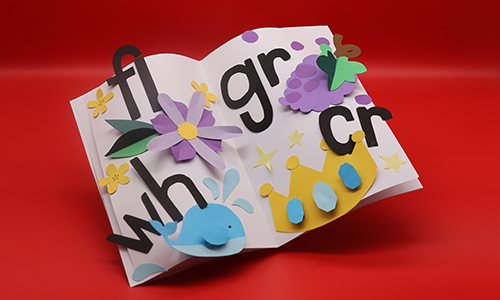
As young kids amaze us by developing reading fluency, they typically move toward greater and greater comprehension of what they read. That’s good: reading comprehension is, after all, the point of learning to read fluently.
But not all kids have enough of what they need to get to reading comprehension. Some kids have strong phonics and word recognition skills and still fail to comprehend. Others show solid, insightful comprehension when you read tothem yet aren’t able to comprehend what they read on their own.
What gives? This sounds complicated.
The Simple View of Reading
It’s helpful to focus on how simple developing reading comprehension actually is. An important model for reading comprehension is one asserted by Philip Gough and William Tunmer. Their model, the Simple View of Reading, is described by a simple formula:
 This is “simple” because it has only two parts: word recognition (WR), which includes decoding, and language comprehension (LC). Just as a simple lever only has two parts, handle and fulcrum, the development of reading comprehension can be modeled as being, at its core, simple.
This is “simple” because it has only two parts: word recognition (WR), which includes decoding, and language comprehension (LC). Just as a simple lever only has two parts, handle and fulcrum, the development of reading comprehension can be modeled as being, at its core, simple.
Word recognition is the ability to turn printed words into the right word sounds, more and more automatically. Phonics instruction aims toward increasing decoding proficiency.
Language comprehension is the ability to understand spoken words in sentences. When we speak with easier words and less complex structures to very small kids, we are reaching toward their less proficient language comprehension.
In this model, word recognition and language comprehension are multiplied together, not added. That’s important because it means this: when one is weak, you can’t just compensate with a heavier dose of the other. Both parts are needed for the end product—reading comprehension—to be true.
You can think of each of the factors as working like a percentage, ranging from 0 (no proficiency at all) to 1 (100%, perfect proficiency). Imagine that word recognition is at full power and language comprehension is only at half power. That’s 1 times 0.5, which gives us a pretty poor value for reading comprehension. Even a student who can read every single word accurately can have poor comprehension. The product, reading comprehension, will be at or below the level of the lower factor. That’s important: whichever of the two proficiencies is weakest is the one that most limits reading comprehension.
We need to do better
How are we doing at finding and targeting the weak—or missing—factor in the reading comprehension equation, student by student? In the US, we have often done a poor job of adequately supporting both word recognition and language comprehension. In too many schools, we have tested and watched for progress in word recognition skills alone. We have often gone so far as to assume that every student with low reading comprehension must need help developing their word recognition skills. But as Sheila Valencia and Marsha Riddle Buly have so clearly shown, readers’ needs vary. Some “automatic word callers,” kids who are able to read with accuracy and even at a solid rate, still lack the language comprehension needed for strong reading comprehension.
What a relief it is to know that reading comprehension is simple, am I right? The key here is to remember that simple does not mean easy. Just having a simple lever doesn’t mean you can lift an elephant later this afternoon, easy peasy. But with well-considered preparation—think instructional savvy and individualization—we can apply our exertion to better points of leverage, meeting all students where they are and helping to fill gaps in order to achieve reading proficiency. While simple is not easy, keeping the Simple View of Reading in mind might help us optimize for that all-important product, reading comprehension.
MAP® Reading Fluency™ can help you assess your early readers in as little as 20 minutes, making it easier to identify where students need the most support and differentiate instruction accordingly. Learn more on our website.




